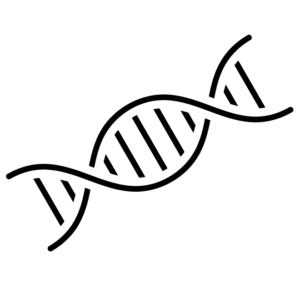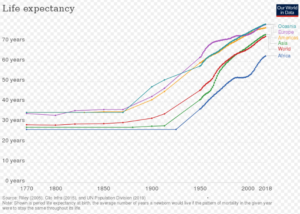We are very familiar with life extension, but mostly it has appeared in the guise of life-saving strategies, like vaccination. The vaccinations for polio and smallpox have saved hundreds of millions of lives, or to put it another way, ‘have enabled hundreds of millions of people to live who otherwise would have died’. Vaccination is an exercise in life extension – but nobody throws up their hands in horror about its huge effect on life expectancy.
John Harris, bioethicist (quote perhaps too optimistic given the virulence of some “anti-vaccination” campaigns), April 2020 (source)
Theme of the month: Covid-19 treatments and the fight against aging
The emergence of the SARS-CoV-2 coronavirus in December 2019 has left many physicians in the dark. Faced with this unknown virus, they have often had to make do with whatever they had to hand to care for their patients, even if it meant testing unapproved drugs and treatments. A meta-study, conducted by the University of Pennsylvania (USA) and published in the journal Infectious Diseases and Therapy, counted all the treatments administered to the first patients with Covid-19. They calculated that 115 different drugs and remedies were prescribed to 9,152 patients. But the study highlights the trial and error approach of the medical teams to find the appropriate remedy.
The purpose of this letter is to provide an overview, for non-specialists on the subject, of the situation as of 20 June 2020 of the most promising research as well as some links with research relating to aging. However, some avenues will not be explored (e.g. ways to strengthen the immune system, including vitamin D).
- Vaccines
Research into coronavirus is breaking all records, 140 research projects have been recorded by the WHO as of 18 June 2020: the development of research for a vaccine usually takes much longer. Although several laboratories are making serious headway, a working vaccine is not for tomorrow!
Messenger RNA vaccines
Vaccination via messenger RNA is taking the lead in the race for a vaccine against the SARS-CoV-2 virus, responsible for the Covid-19 pandemic. It is a vaccine of this type that was the first to enter the clinical trial stage.
In the United States, the Phase II trial of the mRNA-1273 vaccine began May 29, U.S. biotech company Moderna Therapeutics said in a statement. If successful, the Phase III trial could begin as early as July.
The first two European human trials took place April 23 in the United Kingdom and Germany. The ChAdOx 1 vaccine developed by the University of Oxford will be tested on 800 patients, reports the BBC. The BNT162 vaccine developed by the German company BioNTech has also been given the green light to be tested on 200 volunteers.
Recombinant DNA technology
The French pharmaceutical group Sanofi has partnered with the U.S. Department of Health and Human Services to develop a candidate vaccine using “recombinant DNA technology”. It consists of combining the DNA of the virus with the DNA of a harmless virus to create a new cellular entity capable of provoking an immune response. The antigens created by this process can then be replicated on a large scale.
David Loew, executive vice president of Sanofi Pasteur, estimated in February that a candidate vaccine would be available “in less than six months” and potentially enter clinical trials “in about a year to a year and a half”.
The advantage for aging of having vaccines for Covid-19 is, as with the influenza vaccine, to immunize older people to protect them from future contamination.
A universal vaccine against aging is of course currently unimaginable from a scientific point of view. However, some universal vaccinations that are favorable to longevity are conceivable. For example, it is conceivable to extend vaccination for diseases such as herpes. Herpes is often asymptomatic, “underground”. It affects the majority of humans and the vast majority of the elderly. Vaccination could provide a moderate gain of healthy life for those who are free of the condition.
- Antivirals and anti-inflammatory drugs
Chloroquine, a controversial antimalarial drug
A Chinese study, published by the journal BioScience Trends on February 18, 2020, was the first to affirm the efficacy of chloroquine, a drug used against malaria, in the treatment of the SARS-CoV-2 coronavirus and its Covid-19 disease.
Professor Didier Raoult, who is testing chloroquine at the Marseille Infectious diseases University Hospital Institute, said that its effect against the coronavirus was spectacular, with the virus disappearing in six days in three-quarters of patients. But several experts call for caution in the absence of further studies and because of its undesirable effects which can be serious, especially in the event of overdose.
In May, a Lancet study that identified the potential dangers of chloroquine was quickly retracted. A recent double-blind randomized clinical trial against the prophylactic use of chloroquine appeared in the New England Medical Journal.
This case was a superb textbook case for presenting medical science. It was useful to point out the many methodological errors. However, the debate very quickly became a conflict between anti-chloroquine on the one hand and pro-chloroquine on the other. Yet the scientific approach is neither pro nor anti. It values doubt, taking a step back, and is little concerned with our desire for efficacy in a therapy, it is intended to cut through to the reality, not to lull us into reassuring illusions.
Clinical trials, particularly double-blind trials, should have been an absolute priority, better coordinated and faster. It must be said that the enormous mobilization in the fight against the disease has not sufficiently allowed this to happen.
Remdesivir, the first effective treatment on the market?
Remdesivir, developed by the American laboratory Gilead, “acts directly on the virus to prevent its multiplication”. It has been tested in the past for Ebola.
“At the moment there is only one drug that we think could be really effective. And that’s remdesivir,” said Bruce Aylward, a World Health Organization (WHO) official, in March. The European Medicines Agency (EMA) announced on Monday 8 June that it had received an application for a conditional marketing authorization for the antiviral in the European Union.
Research on Covid-related antivirals has led to an acceleration of all research into this class of drugs. However, to date, this has not been applied to the longevity of elderly people not suffering from a viral disease.
Dexamethasone
In June, a steroid, dexamethasone, was shown to have an anti-inflammatory effect that significantly reduced deaths (up to 25%) in the most affected patients.
- Plasma and antibodies
When transfusing convalescent plasma, and thus transfusing blood from a healed patient to a patient who is still ill, it is hoped to generate a “passive immunity transfer”. Antibodies created to fight infection are inserted into a still infected person so that they can act immediately against the disease. This transfer can provoke an even more rapid defense response than with a vaccine. However, since they were not produced directly by the patient’s body, the antibodies transferred will not last and will not provide long-term immunity. Nonetheless, this speeds up the healing process and, in the case of Covid-19, the hope is to prevent the disease from getting worse.
Medical research is exploring different avenues to fight Covid-19. Among them, transfusing the blood – and more specifically the plasma – of cured patients into patients who are still ill is a serious possibility. The French Blood Establishment (EFS) started a clinical trial based on this principle on 7 April. In the United States, the National COVID-19 Convalescent Plasma Project research group is also involved in such experiments.
The advantage for the elderly is to compensate for the lack of defense capability of their immune system by providing them with a dose of antibodies present in the plasma of cured people. More broadly speaking, the replacement of blood by other substances in an elderly organism is one of the extremely promising avenues for longevity. A very recent development is discussed at the end of this letter (see below: This month’s good news).
Regeneron develops a treatment that is both curative and preventive
Last year, the Regeneron laboratory developed a drug, administered intravenously, known as “monoclonal antibodies”, which significantly improved the survival rate of patients affected by the Ebola virus. The drug could work by administering it to people before they are exposed or afterwards, although the effects would only be temporary because the antibodies will not be part of the memory of an individual’s immune system.
- Stem cells
Chinese and American researchers have joined forces to test the effectiveness of stem cells against coronavirus. Their study was published in April 2020.
Stem cells appear to contribute to the rejuvenation and regeneration of other cells. They do this in many ways such as reducing inflammation, secreting substances that protect cells, reducing cell death, providing antioxidant effects, and boosting the immune system’s response.
In 2011, French researchers succeeded in restoring the youthfulness of donor cells over 100 years old by reprogramming them to the stem cell stage, thus demonstrating that the process of cell aging is reversible. The acceleration of stem cell research for Covid-19 may also be useful in the fight against senescence.
This month’s good news: Replacing the blood of older mice with salt water and albumin makes them considerably “younger” .
In the monthly newsletter of May, we referred to a scientific article concerning an “elixir” injected into the bloodstream that would “rejuvenate” rats.
A few days ago, another very promising article appeared in the Aging journal concerning a similar mechanism. Researchers, including a scientist couple specializing in this type of study, Irina and Michael Conboy, replaced half of the blood of elderly mice with a solution of salt water and albumin. The result was spectacular. This dilution has rejuvenating effects on the brain, liver and muscles.
Among the extremely promising aspects of this study :
- the given product is known and costs almost nothing,
- the treatment is very simple,
- the treatment does not pose the ethical problems that would arise with blood transfusions.
However, as with the experiment described last month, there remains a fundamental unexamined question: Is it really possible that the “rejuvenated” mice could live longer, or would the effect be temporary or even negative in the long term?
If the effect is long-lasting (with renewed transfers if necessary), a spectacular future of rejuvenation is in sight.
For more information, please visit:













 air of the metropolis, the inhabitants of the then miserable and overcrowded neighborhoods are dying in their hundreds from cholera. No one yet knows that it is a bacillus that is killing people, and among the most competent scientists many believe that it is the “pestilential” air (literally meaning “plague carrying”) that carries something that triggers the disease.
air of the metropolis, the inhabitants of the then miserable and overcrowded neighborhoods are dying in their hundreds from cholera. No one yet knows that it is a bacillus that is killing people, and among the most competent scientists many believe that it is the “pestilential” air (literally meaning “plague carrying”) that carries something that triggers the disease.